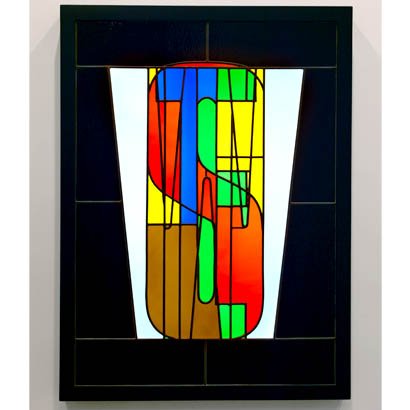
Edition of 6
Overall dimensions: 38 3/4 x 28 3/4 x 2 3/4 inches (98.4 x 73 x 7 cm)
(Inventory #24845)
Edition of 6
Overall dimensions: 38 3/4 x 28 3/4 x 2 3/4 inches (98.4 x 73 x 7 cm)
(Inventory #24845)
Sweet Jesus, Kay Rosen’s first project with BEYER, develops her longstanding use of language as pictorial material in a medium which is new for the artist, stained glass. A wall-mounted sculpture produced in edition of 6, this intimate work is connected to a 2011 series of drawings of phrases depicted as overlapping letters, which were made according to a pair of predetermined constraints: each phrase must begin and end with the same letter, and must bear a formal or stylistic correlation to its meaning. This visual symmetry is thrown into sharp relief by the brilliantly backlit, overlain letters of Sweet Jesus, which can be seen all at once, as a bright abstraction, or identified individually. As a three-dimensional object, the work dramatizes what has been an implicit theme of Rosen’s art of the past four decades: the idea that words, far from being neutral instruments of communication, can possess an obdurate physicality and their own tangible, even sculptural, qualities. In her presentation of the title phrase as translucent, Rosen demonstrates—seemingly paradoxically—how language can resist the transparency often ascribed to it.
Indeed, Rosen’s work in a variety of mediums (painting, drawing, editions, and installations) has cleverly shown how words’ physical qualities—typeface, color, spacing, scale, positioning—can alter legibility and, in turn, affect meaning. She favors those instances of language that foreground linguistic materiality and confound the processes of seeing and reading, such as misspellings, homonyms, homophones, rhymes, puns, palindromes, and double-entendres. This use of word as image, and the rule-based methods according to which this work was created, aligns Rosen with a text-based Conceptualist heritage that includes Lawrence Weiner and Ed Ruscha, but other ties are also evident. Her chosen words and phrases, like those of her contemporary Jenny Holzer, often have pointed political implications, while on a purely formal register, the stacked letterforms of Sweet Jesus call up Jasper Johns’s overlapping numbers and alphabets. And if the work’s means and devotional size evoke yet another tradition—a history of religious art that encompasses illuminated manuscripts and stained glass windows—the link is hardly unequivocal. “Sweet Jesus” is, after all, often used as an expression of surprise or stupefaction.
To fabricate the stained glass panel, BEYER worked with material from Glasshute Lamberts in Waldsassen, West Germany, widely considered to be the world’s finest producer of traditional hand-blown glass. The Lamberts’ palette comprises five hundred standard colors that transmit light superbly. The LED light panel, which minimizes the thickness of the wall sculpture, provides an efficient energy source, with 2,200 lumens of light. The LED light source produces almost no heat, resulting in no measureable thermal build-up, and has nearly five times the life span of the most efficient fluorescent bulbs. It lasts over 100,000 hours, virtually eliminating the need for replacements. The sculpture is easily mounted on the wall via a cleat on its reverse side. An electrical cord on its underside can simply be plugged into a regular outlet, and a small switch turns the light on and off.
Kay Rosen’s investigation into the visual possibilities of language has been her primary focus since 1968, when she traded in the academic study of languages for the study of language-based art. Through paintings, drawings, murals, prints, collages, and videos, Rosen has sought to generate new meaning from everyday words and phrases by substituting scale, color, materials, composition, graphic design, and typography for the printed page.
While political issues often form the bedrock of Rosen’s artwork, she insists that her work is driven not by politics, but by language, and she follows it to whatever place it takes her. Rosen loves the physical act of drawing and painting, and materially her paintings and drawings are intensively rendered; however, she considers language to be found material, conceptually placing her in the more passive role of a cognitive observer and enabler of language. The writer Rhonda Lieberman described her as a revealer of language who “shows it doing things that are totally above, beyond, and/or below its function as a mode of communication.”
Rosen’s work has been described as sculpture, poetry, architecture, and performance. Roberta Smith once called her a “writer’s sculptor” and Eileen Myles called her the “poet of the art world.” In a 2014 piece for Art In America, Rosen wrote: “The linguist in me wanted meaning to be carried by the structure of the words, not type style; the inner painter insisted that color convey meaning; the sculptor in me obsessed about the construction of letterforms through materials and process; and any poetic instincts strove for efficiency.”
Kay Rosen has been the subject of numerous articles, reviews, and group and solo exhibitions, including in 1998 a two-venue mid-career survey entitled Kay Rosen: Li[f]eli[k]e, curated by Connie Butler and Terry R. Myers at the Los Angeles Museum of Contemporary Art and Otis College of Art Design. She has been the recipient of awards that include a Guggenheim Foundation Fellowship in 2017 and three National Endowment for the Arts Visual Arts Grants. Her work is included in many institutional and private collections. Rosen taught at The School of the Art Institute of Chicago for twenty-four years. She was born and raised in Corpus Christi, Texas and lives in New York City and Gary, Indiana.
10 Newbury Street, Boston, Massachusetts 02116
617-262-4490 | info@krakowwitkingallery.com
The gallery is free and open to the public. Please note our summer schedule:
June
Tuesday – Saturday, 10–5:30
(Open on Juneteenth)
July 1–25
Tuesday – Friday, 10–5:30
(Closed Friday, July 4)
July 29 – September 1
Open via appointment
Beginning September 2
Tuesday – Saturday, 10–5:30